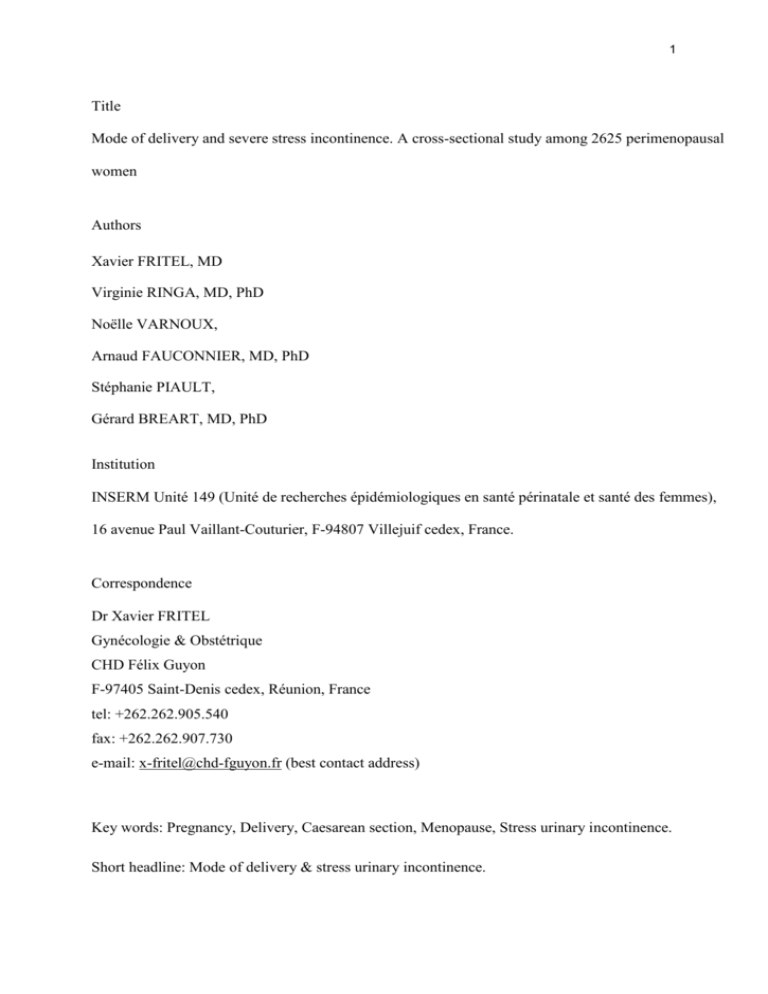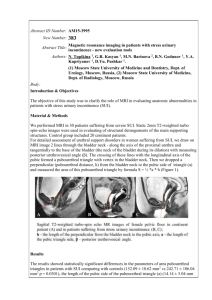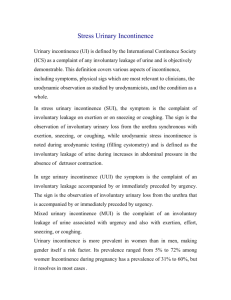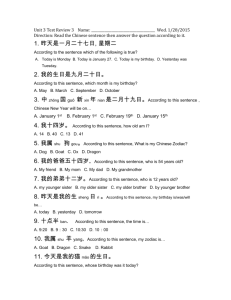Obstetrical history and stress urinary incontinence. A - HAL
advertisement

1 Title Mode of delivery and severe stress incontinence. A cross-sectional study among 2625 perimenopausal women Authors Xavier FRITEL, MD Virginie RINGA, MD, PhD Noëlle VARNOUX, Arnaud FAUCONNIER, MD, PhD Stéphanie PIAULT, Gérard BREART, MD, PhD Institution INSERM Unité 149 (Unité de recherches épidémiologiques en santé périnatale et santé des femmes), 16 avenue Paul Vaillant-Couturier, F-94807 Villejuif cedex, France. Correspondence Dr Xavier FRITEL Gynécologie & Obstétrique CHD Félix Guyon F-97405 Saint-Denis cedex, Réunion, France tel: +262.262.905.540 fax: +262.262.907.730 e-mail: x-fritel@chd-fguyon.fr (best contact address) Key words: Pregnancy, Delivery, Caesarean section, Menopause, Stress urinary incontinence. Short headline: Mode of delivery & stress urinary incontinence. 2 Abstract Objective: To estimate the prevalence of severe stress urinary incontinence among perimenopausal women and to examine potential obstetrical risk factors. Design: Mail survey of female volunteers for epidemiological research. Setting: Postal questionnaire on stress urinary incontinence (SUI). Population: 3114 women aged 49 – 61 years who comprised the GAZEL cohort. Main outcome measure: Prevalence of severe SUI defined by the response “often” or “all the time” to the question “Does urine leak when you are physically active, cough or sneeze?” Methods: Logistic regression using data from the entire cohort to estimate the impact of risk factors. A second logistic regression using data from women who had given birth included obstetric history. Results: 2625 women (85%) completed and returned the questionnaire The frequency of SUI reported in the preceding four weeks was: “never” 32%, “occasionally” 28%, “sometimes” 26%, “often” 10%, and “all the time” 5%. Prevalence of severe SUI was lowest among nulliparous women (7%), but it was similar among parous women regardless of birth number (14 – 17%). The prevalence of severe SUI was not associated with mode of delivery (14% for women delivered by caesarean only versus 16% for vaginal births). Significant risk factors for severe SUI were high body mass index (>30), diabetes mellitus, previous incontinence surgery, parity, and first delivery under the age of 22 years. Conclusion: Pregnancy itself is a risk factor for severe SUI among women who reach the age of 50. In this age group the impact of the mode of delivery (spontaneous, forceps or caesarean) on severe SUI is slight. 3 Introduction Stress urinary incontinence (SUI) is common in women, and the prevalence peaks at around the age of 50 years.1, 2 The principal known risk factors are age, body mass index (BMI) and parity.1-5 Several studies report that SUI occurs less often after caesarean than vaginal deliveries.6-9 The medical community has begun discussing the possible benefits of elective Caesarean section to prevent future continence problems, and some obstetricians would choose caesarean over vaginal deliveries for themselves or their partners because of fear of SUI.10 The relation between SUI and pregnancy is complex. The interval between the first pregnancy and the onset of bothersome symptoms is quite long: the mean age of surgery at SUI is 54 years, and first childbirth in this age group dates back approximately 30 years.11 It is therefore difficult to establish a firm link between an obstetrical event and the need for a surgical procedure for SUI many years later. Moreover, there is no proven causal link between the urinary problems of the early postnatal and those occurring around the menopause. Pregnancy related problems often disappear or regress after delivery. The long-term follow-up study by Viktrup showed that the prevalence of SUI was 32% during the first pregnancy, diminished postpartum to 6% at 3 months and increased again to 30% 5 years later.12 It is also not proven that pregnancy/postpartum stress leakage and perimenopausal leakage share the same pathophysiology. Parity is a risk factor for SUI only among young women; the association is highest among those 20-34 years, and non-existent after 65 years.3, 13 The effects of pregnancy and delivery on continence may therefore fade with time. This study was conducted to estimate the prevalence of severe SUI around menopause and to assess the risk factors for this symptom with a questionnaire bases survey, including questions about obstetrical history. 4 Methods Our population was selected from the French GAZEL cohort, which began in 1989 with 20 000 men and women employed by the French national power company (EDF-GDF) who volunteered to participate in epidemiological research.14 Women of the GAZEL cohort aged 45-50 years between 1990 and 1996 (n = 3114) were included in a separate prospective survey, termed the “Women and their Health” project. The principal objective of this study is to examine women's health as they reach menopause and afterwards.15 They receive a general health questionnaire each year as part of the overall GAZEL survey and a specific questionnaire about women’s health issues every three years. For the study reported here an additional questionnaire about urinary symptoms and obstetrical history was mailed in 2000 to all the women in this survey. The study data were extracted from this questionnaire with social, demographic, life-style and health characteristic data obtained from previous questionnaires to compare respondents and non-respondents. SUI was assessed by responses to the question “Does urine leak when you are physically active, cough or sneeze?” Possible responses were: “never”, “occasionally”, “sometimes”, “often”, or “all the time”.16 The question covered the previous four weeks. “Occasionally” was defined as less than one third of the time; “sometimes” as between one and two thirds of the time, and “often” as more than two thirds of the time. Women who answered “often” or “all the time” were considered to have severe SUI. We tested the following potential risk factors: general characteristics (age at questionnaire, educational level, BMI, and menopausal status), medical history (diabetes mellitus, hysterectomy, surgery for incontinence or pelvic organ prolapse), life-style (income, marital status, smoking habits, regular physical exercise), and obstetrical history (parity, age at delivery, birth weight, mode of delivery). We first conducted a bivariate analysis between women with severe SUI and all other grades. Significant variables were included in a multivariate analysis with a stepwise logistic regression. Mode of delivery was forced into the model, and other variables were eligible for entry if 5 they had a p value < 0.05 in the bivariate analysis. We constructed a logistic regression model for the entire population and a second model only for parous women. We constructed two variants of the latter: in Model 2A we took into account the mode of first delivery (spontaneous, forceps or caesarean delivery). In model 2B the mode of all deliveries was considered (at least one vaginal delivery or caesarean section only). Because of the retrospective nature of the obstetrical questionnaire, we did not plan to distinguish elective and emergency caesareans. All analyses were performed with Statview (SAS Institute Inc. Cary, NC, USA). The GAZEL cohort scientific committee and the French committee for health research data approved this study, which received no external funding. 6 Results Of 3114 questionnaires sent out, 2625 (84%) usable copies were returned. Comparison between respondents and non-respondents showed no significant differences in age, BMI, parity, marital status, or smoking. On the other hand, respondents had a higher educational level (19% with high school diploma or more versus 14%; p=0.01, chi² test). Tables 1 and 2 detail the population characteristics and obstetric history data for all women, and for those parous women respectively. Of the 163 women who gave birth to their first child by caesarean section, only 22 (13%) had a subsequent vaginal delivery. Of the 2098 women with initial vaginal deliveries, only 60 (3%) later had caesarean deliveries. SUI frequency in the 4 weeks before response was reported as “never” by 829 (32%); “occasionally” by 724 (28%); “sometimes” by 686 (26%); “often” by 260 (10%), and “all the time” by 126 (5%) women, giving 386 women (15%) considered to have severe SUI. In this group, 206 (53%) considered SUI “a serious problem”, 94 (24%) “quite a problem”, 81 (21%) a “slight problem”, and only 3 (1%) “not a problem”. 186 women (46%) wore pads; 279 (72%) reported they wanted treatment; 241 (62%) had already discussed it with their physician, and 147 (38%) had already undergone an unsuccessful treatment. SUI severity increased with parity (Table 3) but was similar in women with vaginal or only caesarean deliveries (Table 4). Results of the bivariate analysis are shown in Table 5, and the multivariate analyses in Table 6. Variables introduced in the first logistic regression, which considered the entire population, were BMI, history of diabetes, hysterectomy, incontinence or pelvic organ prolapse surgery, and parity. In this multivariate model, the risk of severe SUI increased with BMI, diabetes, and previous UI surgery (Table 6, Model 1). The risk of SUI was higher among parous than nulliparous women, but the differences between those with one, two, or more deliveries were not significant. Hysterectomy and previous pelvic organ prolapse surgery were not independently associated with severe SUI. 7 An additional logistic regression was undertaken for the parous women only (Table 6, Model 2A & B). It included BMI, diabetes, previous UI surgery, age at first delivery and mode of delivery. Multivariate analysis showed that neither mode of first delivery (Table 6, Model 2A) nor mode of all deliveries (Table 6, Model 2B) was associated with severe SUI in our population. An independent association was found among parous women with age at first delivery < 22 years, who had a higher risk of severe SUI. 8 Discussion The prevalence of severe SUI in our population of perimenopausal women was 15%. Significant risk factors were BMI, diabetes, incontinence surgery, parity and youthful delivery (age less than 22 years). Our population differs slightly from the overall population of women employees at the power company, which in turn differs from the general French female population.14 Nonetheless these differences concern variables (marital status, educational level) that are not associated with the risk of SUI. We therefore think that the risk factors identified here can be extrapolated to the general population. Details of obstetrical history were collected retrospectively. No alternative was available because France has no national birth registry, and maternity unit records are destroyed after 20 years. Memory bias for obstetrical variables such as mode of delivery is nonetheless improbable. We did not plan to collect information concerning the type (elective or emergency) of caesarean because we presumed that this retrospective information would not be reliable. We note however that the women questioned had given birth for the first time 30 years earlier on average, at a time when elective caesareans, especially for a first delivery, were still relatively rare. In view of the low caesarean rate in this population (7%), it is probable that even if this information had been available, it would not have been significant. We deliberately limited our definition of stress urinary incontinence to women reporting leaks “often” or “all the time” because our principal objective was to explore the effect of a caesarean on incontinence sufficiently severe to result in surgical treatment. In our survey more than half (53%) the women reporting severe SUI considered it a serious problem, almost three quarters (72%) wanted treatment, almost two thirds (62%) had already discussed it with their physician, and more than a third (38%) have already undergone unsuccessful treatment. 9 While postpartum studies have found that the prevalence of SUI is lower after caesarean delivery,6, 7 we found no protective effect against SUI by caesarean section in our population. Even four years after the first delivery, SUI is reported to be less likely in women with caesarean deliveries (OR=0.3; 95% CI 0.1–0.9).8 Only a few studies, however, have investigated the association between mode of delivery and SUI around menopause. The survey of Rortveit et al analysed the association between prevalence of SUI (pure or mixed) and mode of delivery (vaginal only versus caesarean section only) according to age group. SUI prevalence was higher among those aged 30-39 years who delivered vaginally (19%) compared with those delivered by caesarean (10%, OR=2.1, 95%CI: 1.453.13) but the difference was not significant among those aged 40-49 years (24% versus 18%) or 50-64 years (27% versus 20%).9. In the study by Kuh et al of 1333 women aged 48 years, SUI prevalence was slightly higher among women with only vaginal deliveries compared with women delivered only by caesarean section (52% versus 44%) but again the difference was not significant.17 Several hypotheses may explain the discrepancies between these data and ours. Emergency caesarean section may not be protective for urinary continence. Accordingly a year after a first delivery Groutz et al found a prevalence of stress urinary incontinence of only 3% after elective caesarean compared with 12% after caesarean during labour and 10% after vaginal delivery.18 Caesarean section during labour appears to carry a risk of nerve injury that elective caesarean section does not.19, 20 The mobility of the bladder neck also seems higher after caesarean section during labour.21 The protective effect of caesarean section that is observed postpartum and few years later may disappear with age and multiple pregnancies. We know that the association between SUI and parity reported before 35 years disappears after 65 years.3, 13 In Wilson's work, the prevalence of postpartum urinary incontinence was similar in women giving birth for the third time or more by caesarean (39%) and in those giving birth for the third time or more vaginally (38%).7 After several years the difference observed initially between vaginal delivery and caesarean section is no longer apparent. The protective effect of caesarean section 10 may also be so slight that it can be measured only in very large samples: in our population only 137 had only caesarean deliveries. Conclusion Pregnancy itself is a risk factor for severe SUI among women in their fifties. In this age group the impact of the mode of delivery (spontaneous, forceps or caesarean) on severe SUI is slight. 11 References 1 Hannestad YS, Rortveit G, Sandvik H, Hunskaar S. A community-based epidemiological survey of female urinary incontinence: the Norwegian EPINCONT Study. J Clin Epidemiol 2000;53:1150–7. 2 Simeonova Z, Milsom I, Kullendorff AM, Molander U, Bengtsson C. The prevalence of urinary incontinence and its influence on the quality of life in women from urban Swedish population. Acta Obstet Gynecol Scand 1999;78:546–551. 3 Rortveit G, Hannestad YS, Daltveit AK, Hunskaar S. Age and type dependent effects of parity on urinary incontinence: the Norwegian EPINCONT study. Obstet Gynecol 2001;98:1004–10. 4 Foldspang A, Mommsen S, Djurhuus JC. Prevalent urinary incontinence as a correlate of pregnancy, vaginal childbirth and obstetric techniques. Am J Public Health 1999;89:209–12. 5 Milsom I, Ekelund P, Molander U, Arvidsson L, Areskoug B. The influence of age, parity, oral contraception, hysterectomy and menopause on the prevalence of urinary incontinence in women. J Urol 1993;149:1459–62. 6 Hannah ME, Hannah WJ, Hodnett ED et al. Outcomes at 3 months after planned cesarean vs planned vaginal delivery for breech presentation at term. JAMA 2002;287:1822–31. 7 Wilson PD, Herbison RM, Herbison GP. Obstetric practice and the prevalence of urinary incontinence three months after delivery. Br J Obstet Gynaecol 1996;103:154–161. 8 Fritel X, Fauconnier A, Levet C, Bénifla JL. Stress urinary incontinence four years after the first delivery: a retrospective cohort study. Acta Obstet Gynecol Scand 2004;83:941-5 9 Rortveit G, Daltveit AK, Hannestad YS, Hunskaar S. Urinary incontinence after vaginal delivery or cesarean section. N Engl J Med 2003;348:900–7. 10 Al-Mufti R, McCarthy A, Fisk NM. Obstetricians' personal choice and mode of delivery. Lancet 1996;347:544. 11 Waetjen LE, Subak LL, Shen H et al. Stress urinary incontinence surgery in the United States. Obstet Gynecol 2003;101:671–6. 12 Viktrup L. The risk of lower urinary tract symptoms five years after the first delivery. Neurourol Urodyn 2002; 21: 2–9. 12 13 Foldspang A, Mommsen S, Lam GW, Elving L. Parity as a correlate of adult female urinary incontinence prevalence. J Epidemiol Commmunity Health 1992;46:595–600. 14 Goldberg M, Chastang JF, Leclerc A et al. Socioeconomic, demographic, occupational and health factors associated with participation in a long-term epidemiologic survey: a prospective study of the French GAZEL cohort and its target population. Am J Epidemiol 2001;154:373–84. 15 Ringa V, Ledésert B, Bréart G. Determinants of hormone replacement therapy among postmenopausal women enrolled in the French GAZEL cohort. Osteoporosis Int 1994;4:16–20. 16 Jackson S, Donovan J, Brookes S, Eckford S, Swithinbank L, Abrams P. The Bristol Female Lower Urinary Tract Symptoms questionnaire: development and psychometric testing. Br J Urol 1996;77:805–12. 17 Kuh D, Cardozo L, Hardy R. Urinary incontinence in middle-aged women: childhood enuresis and other lifetime risk factors in a British prospective cohort. J Epidemiol Community Health 1999;53:453–8. 18 Groutz A, Rimon E, Peled S et al. Cesarean section: Does it really prevent the development of postpartum stress urinary incontinence? a prospective study of 363 women one year after their first delivery. Neurourol Urodyn 2004;23:2–6. 19 Allen RE, Hosker GL, Smith ARB, Warrell DW. Pelvic floor damage and childbirth: a neurophysiological study. BJOG 1990;97:770–9. 20 Sultan AH, Kamm MA, Hudson CN. Pudendal nerve damage during labour: prospective study before and after childbirth. BJOG 1994;101:22–8. 21 Dietz HP, Bennett MJ. The effect of childbirth on pelvic organ mobility. Obstet Gynecol 2003;102:223–8. 13 Table 1. Population characteristics Characteristics (n = 2625) Age at questionnaire High school diploma Monthly income Marital status Smoking Regular physical exercise Body mass index (kg/m²) Menopausal status Diabetes Hysterectomy UI surgery n (%) < 52 641 (24) 52–57 1388 (53) 58 596 (23) No 2058 (78) Yes 505 (19) < 1600 € 512 (20) 1600-2592 € 1054 (40) 2592 € 937 (36) Couple 1748 (67) Alone 598 (23) No 2284 (87) Yes 305 (12) No 1208 (46) Yes 1362 (52) < 25 1658 (63) 25–30 660 (25) > 30 248 (9.4) Premenopausal 527 (20) Postmenopausal with HRT 1300 (50) Postmenopausal without HRT 784 (30) No 2488 (95) Yes 71 (2.7) No 2108 (80) Yes 460 (18) No 2550 (97) Yes 69 (2.6) Pelvic organ prolapse surgery No Parity 2491 (95) Yes 70 (2.7) 0 308 (12) 1 769 (29) 2 1203 (46) 3+ 345 (13) Where percentages do not add to 100%, there were some missing data (0.2 – 11%). 14 Table 2. Obstetrical history of deliveries among parous women Factor Range n (%) Age at 1st delivery (years) < 22 602 (26) 22–26 1152 (50) 27 559 (24)) < 3.0 617 (27) 3.0–4.0 1517 (65) > 4.0 129 (5.6) < 3.0 364 (16) 3.0–3.9 1671 (72) 4.0 244 (11) Spontaneous 1760 (76) Forceps 382 (16) Caesarean 163 (7.0) Vaginal, at least 1 2168 (94) Caesarean only 137 (5.9) 1st birth weight (kg) Largest birthweight (kg) Mode of 1st delivery Mode of all deliveries N=2317. Where percentages do not add to 100%, there were some missing data (0.2 – 2%). 15 Table 3. SUI severity according to parity. Parity 0 n (%) 1 n (%) 2 n (%) 3+ n (%) “never” 141 (46) 278 (36) 309 (26) 101 (29) “occasionally” 83 (27) 205 (26) 351 (29) 85 (24) “sometimes” 62 (20) 182 (24) 342 (28) 100 (29) “often” 15 (4.8) 65 (8.4) 138 (11) 42 (12) “all the time” 7 (2.3) 39 (5.0) 63 (5.2) 17 (4.9) SUI Chi² test, p < 0.0001. Data missing for 15 women (0.6%). 16 Table 4. SUI severity according to mode of deliveries. Mode of all deliveries SUI Vaginal n (%) Caesarean only n (%) “never” 639 (29) 48 (35) “occasionally” 592 (27) 43 (31) “sometimes” 594 (27) 27 (20) “often” 233 (11) 12 (8.8) “all the time” 112 (5.1) 7 (5.1) Chi² test, p = 0.39. Data missing for 25 women (1.1%). 17 Table 5. Association between women's characteristics and severe SUI: bivariate analysis. Women's characteristics Age at questionnaire < 52 52–57 58 High school No diploma Yes Monthly income > 1600 € 1600-2592 € 2592 € Marital status Couple Alone Smoking No Yes Regular physical No exercise Yes Body mass index < 25 (kg/m²) 25–30 > 30 Menopausal status Premenopausal Post with HRT Post without HRT Diabetes No Yes Hysterectomy No Yes UI surgery No Yes Pelvic organ No prolapse surgery Yes Parity 0 1 2 3+ st Age at 1 delivery < 22 (years) 22–26 27 1st birth weight < 3.0 (kg) 3.0–3.9 4.0 Heaviest birth < 3.0 weight 3.0–3.9 (kg) 4.0 Severe SUI prevalence % Bivariate analysis OR (95%CI) 13 15 15 1 1.3 (1.0-1.6) 1.3 (0.9-1.7) 15 12 14 16 14 1 0.8 (0.4-1.7) 1 1.2 (0.7-1.4) 1.0 (0.7-1.4) 14 16 15 11 16 14 12 17 28 15 15 13 14 28 14 18 14 32 14 26 7.1 14 17 17 20 14 14 1 1.1 (0.7-1.4) 1 0.7 (0.5-1.1) 1 0.8 (0.7-1.0) 1 1.4 (1.1-1.8) 2.8 (2.0-3.8) 1 1.0 (0.8-1.3) 0.8 (0.6-1.1) 1 2.3 (1.4-4.0) 1 1.4 (1.1-1.8) 1 2.8 (1.7-4.7) 1 2.1 (1.2-3.6) 0.5 (0.3-0.8) 1 1.3 (1.0-1.7) 1.3 (0.9-1.9) 1.5 (1.1-1.9) 1 1.0 (0.7-1.3) 17 16 12 1 0.9 (0.7-1.2) 0.7 (0.4-1.2) 17 16 14 1 0.9 (0.7-1.2) 0.8 (0.5-1.3) 18 Mode of 1st delivery Mode of all deliveries Spontaneous Forceps Caesarean Vaginal, at least 1 Caesarean only 17 13 13 16 14 1 0.8 (0.5-1.0) 0.8 (0.5-1.3) 1 0.9 (0.5-1.4) Analyses used logistic regression. Variables not significant (p > 0.05) during bivariate analysis were not introduced in multivariate analysis. Multivariate analysis of included variables is shown in Table 6. 19 Table 6. Association between women's characteristics and severe SUI: multivariate analysis. Multivariate analysis Women's characteristics Model 1 OR (95%CI) Model 2A OR (95%CI) Model 2B OR (95%CI) Body mass index (kg/m²) < 25 25–30 > 30 1 1.4 (1.1-1.8) 2.6 (1.9-3.6) 1 1.3 (1.0-1.7) 2.5 (1.8-3.5) 1 1.3 (1.0-1.7) 2.5 (1.8-3.5) Diabetes No Yes 1 1.8 (1.0-3.2) 1 1.6 (0.9-2.8) 1 1.6 (0.9-2.9) Hysterectomy No Yes 1 1.1 (0.9-1.5) UI surgery No Yes 1 2.1 (1.2-3.7) Pelvic organ prolapse surgery No Yes 1 1.5 (0.8-2.7) not introduced not introduced Parity 0 1 2 3+ 0.5 (0.3-0.8) 1 1.2 (1.0-1.6) 1.2 (0.8-1.7) not introduced not introduced not introduced 1 2.3 (1.3-4.0) Age at 1st delivery < 22 (years) 22–26 27 not introduced 1.4 (1.1-1.9) 1 1.0 (0.7-1.3) Mode of 1st delivery Spontaneous Forceps Caesarean not introduced 1 0.8 (0.6-1.1) 0.8 (0.5-1.3) Mode of all deliveries Vaginal, at least 1 Caesarean only not introduced not introduced 1 2.3 (1.4-4.0) 1.4 (1.1-1.9) 1 1.0 (0.7-1.3) not introduced not introduced 1 0.8 (0.5-1.4) Model 1 considered the entire population (n=2625). Model 2 considered only parous women (n=2317) with two variants: Model 2A considered mode of first delivery while Model 2B considered mode of all deliveries. Variables concerning deliveries were not introduced in Model 1 and variables without signification in Model 1 were not introduced in Model 2.




